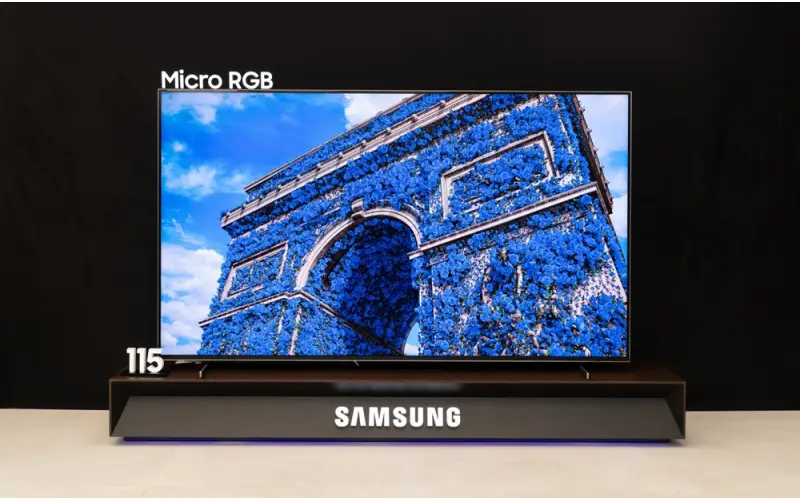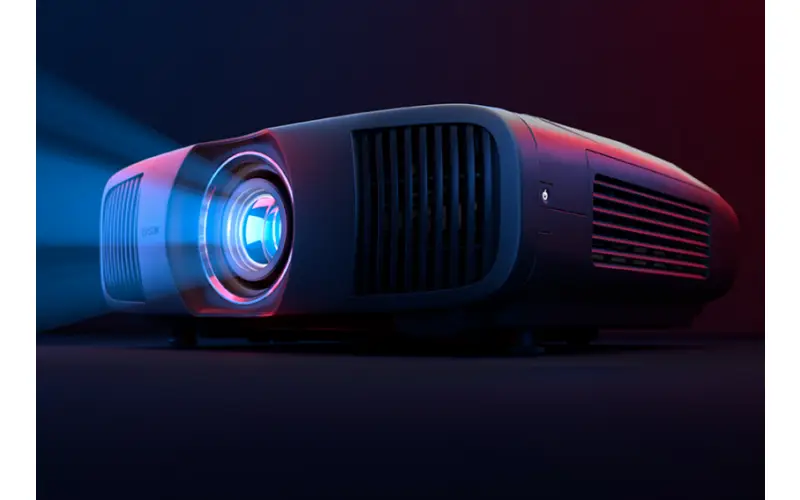By: Dipin Sehdev
In a year that’s already seen bold steps in display innovation, Samsung has just unveiled something that could reshape the trajectory of ultra-premium TVs — the world’s first Micro RGB TV. Debuting in a massive 115-inch model, this new technology promises the precise light control of OLED with the punch, brightness, and scale of LED — all in one package. It’s a bold claim, but the tech behind it suggests this isn’t just marketing hype.
And this isn’t happening in isolation. Earlier this year, Sony announced its own RGB Mini-LED technology, signaling that the industry is gearing up for a new arms race in color precision and backlight control. Now, with Samsung’s commercial launch of Micro RGB, the competition just got a lot more interesting — and a lot more real.
What Exactly is Micro RGB?
At its core, Micro RGB is a next-generation LED backlight system where each red, green, and blue LED is its own individually controlled element — each one measuring less than 100 micrometers in size. Instead of relying on larger white LEDs (like in traditional Mini LED backlights) that shine through color filters, Micro RGB uses true RGB LEDs to create pure, distinct wavelengths of red, green, and blue light.
This means:
-
No white LED dilution — colors are more saturated and accurate.
-
Extremely precise local dimming — thousands more independently controllable zones.
-
Brighter than OLED while still delivering deep blacks — the dream combination.
In simple terms, Micro RGB merges the benefits of OLED and LED: OLED-like contrast and per-pixel color control, with LED’s brightness and resistance to burn-in, and the ability to scale up to enormous sizes like 115 inches without sacrificing image quality.
How It Differs from Micro LED and Mini LED
It’s worth noting where this tech sits in Samsung’s display hierarchy:
-
Mini LED (Neo QLED): Uses small white LEDs with color filters. Great brightness and local dimming, but not as color-precise.
-
Micro RGB: Uses ultra-small true RGB LEDs as a backlight behind an LCD layer, for massive gains in color accuracy and dimming precision.
-
Micro LED: Self-emissive RGB LEDs for each pixel, no LCD layer. The ultimate in picture quality, but currently prohibitively expensive and difficult to manufacture at scale.
Samsung positions Micro RGB as a step above Neo QLED but below Micro LED in price and performance — a sweet spot for people who want high-end picture quality at a fraction of Micro LED’s six-figure price tag.
The Tech Under the Hood
Samsung’s debut Micro RGB model packs a serious feature list:
Panel & Backlight:
-
115-inch 4K LCD panel
-
Micro RGB backlight with <100µm red, green, and blue LEDs
-
100% BT.2020 color gamut coverage
-
HDR10+ Adaptive and HDR10+ Gaming certified
-
Glare Free coating for reduced reflections
Processing & AI Features:
-
Micro RGB AI Engine with real-time frame analysis
-
Micro RGB Color Booster Pro for scene-by-scene color enhancement
-
AI Motion Enhancer Pro for smoother motion without soap opera effect
-
AI Upscaling Pro to upgrade lower-quality content to near-4K
Audio:
-
70W RMS 4.2.2-channel speaker system with Dolby Atmos
-
Object Tracking Sound+, Adaptive Sound Pro, and Q-Symphony
-
360 Audio for Galaxy Buds integration
Smart Features:
-
Tizen OS with 7 years of OS upgrades
-
Samsung Vision AI with generative AI-powered Bixby assistant
-
SmartThings Hub with Matter controller support
-
Gaming features: 144Hz VRR, AMD FreeSync Premium Pro, AI Auto Game Mode, Super Ultra Wide Game View
Connectivity:
-
Wi-Fi 5, Bluetooth 5.3, AirPlay 2
-
Four HDMI 2.0 ports (one eARC)
-
Two USB Type-A, Ethernet, Optical audio out
Availability and Pricing
The Samsung Micro RGB TV launched first in South Korea at KRW 44.9 million (about $32,325 USD). Samsung has confirmed it will arrive in the U.S. later this year, with additional global rollouts in 2025. More sizes are expected, potentially making the tech accessible to people who don’t have room (or budget) for a 115-inch screen.
By comparison, a similar-sized Samsung Micro LED TV can run upwards of $150,000 USD, making the Micro RGB a dramatically more attainable entry into the top-tier display market.
How It Compares to Sony’s RGB Mini-LED
Sony’s earlier RGB Mini-LED announcement was a sign that major manufacturers are moving away from traditional white LED backlighting. While both approaches aim for true RGB light sources for improved color fidelity, Samsung’s Micro RGB uses smaller LEDs and more precise control, suggesting higher potential contrast and better scaling to very large sizes.
If Sony’s tech makes its way into a flagship Bravia model, we may see an interesting showdown in 2026 — one that could push HDR performance, gaming response, and cinematic reproduction to new heights.
Why This Matters for the Future of TVs
Micro RGB is more than just a new product — it’s a strategic bridge technology. It allows manufacturers to deliver near-Micro LED quality at a much lower cost, in much larger sizes than OLED can economically achieve. For consumers, that means:
-
Bigger screens without losing black levels or color accuracy
-
Better HDR performance thanks to pure RGB light sources
-
Longer lifespan without burn-in risk
It’s also a safer bet for mass production — something Micro LED still struggles with.
CES 2026: Expect a Flood of Micro RGB Announcements
Samsung’s launch is almost certainly the first wave in a broader movement. With Sony already in the RGB Mini-LED game, it’s highly likely that LG, TCL, Hisense, and others will show off their own Micro RGB or equivalent technologies at CES 2026.
Expect to see:
-
More sizes, from 65 inches up to wall-dominating 150+ inches
-
Higher refresh rates for gaming-focused models
-
8K Micro RGB prototypes
-
Integrations with next-gen console and PC gaming tech
If CES 2024 was about Mini LED becoming mainstream, CES 2026 could be remembered as the year Micro RGB went global.
Final Thoughts
Samsung’s 115-inch Micro RGB TV isn’t just a milestone for the company — it’s a milestone for display technology as a whole. By blending the color purity and contrast precision of OLED with the brightness, scale, and durability of LED, Micro RGB could very well become the default high-end TV technology of the next decade.
With its attainable (by flagship standards) pricing, broad feature set, and promise of more models to come, Samsung has set the tone for a new era in big-screen home entertainment. Now the question isn’t if competitors will follow — it’s how quickly.




